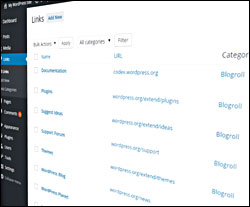 As you continue to learn more about using WordPress, you may occasionally come across something called a blogroll.
As you continue to learn more about using WordPress, you may occasionally come across something called a blogroll.
WordPress refers to a list of hyperlinks pointing to other sites or pages that display on your sidebar section as a blogroll.
According to official WordPress documentation …
“The term ‘blogroll’ was originally used because it was a list of links to other blogs, but you can include links to any sites.”
The Links Manager lets you add and manage links to your WordPress sidebar area (e.g. a “We Use And Recommend” section) using widgets.
![]()
Before the release of version 3.5, Links were a core feature of the WordPress CMS. From v.3.5 onwards, the Link Manager section was removed …
Before …
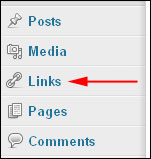
(WordPress Links Manager Feature – pre v3.5)
After …
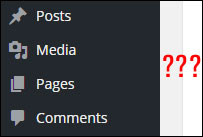
(Links – no longer shown in the WordPress dashboard menu after WordPress v 3.5)
If you have had an earlier version than 3.5 installed and updated your installation, the Links Manager would have been removed, unless you have previously used it.
How To Add A Link Section To WordPress
![]()
You can add a link section to your sidebar menu by creating a custom menu, or use a plugin like the one shown in the tutorial below.
If the Links feature is not visible when you log into your WP dashboard you will need to install a plugin. This tutorial shows you how to add and manage links on your sidebar using WordPress plugins.
Link Manager

(Link Manager)
Plugin Download URL
http://wordpress.org/plugins/link-manager
Description Of Plugin
Use this plugin to display the default Links Manager, even if you update to a later version of WordPress or remove all of your current links.
Note: All this plugin does is add a single line of code to WordPress to restore the hidden feature. When we last checked, this plugin had not been updated for a while, but it should still work fine. If you don’t want to use the Link Manager plugin, then use the plugin below instead, or contact us for help editing your site’s template code.
Simple Links

(Simple Links)
Download URL
https://wordpress.org/plugins/simple-links/
Description
This plugin recreates the concept of the built-in Link Manager while removing the shortcomings of the deprecated feature.
Installing The Plugin
Let’s install the Link Manager plugin.
In your WordPress administration menu, select Plugins > Add New …
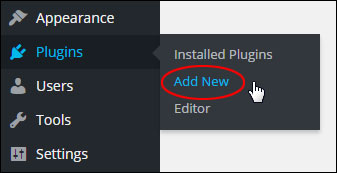
(Plugins – Add New)
Select the Install Plugins > Search tab, type in “link manager” into the search field and hit Enter …
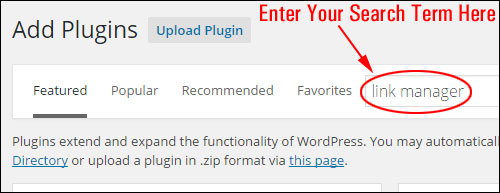
Find the plugin in the search results screen and click Install Now …
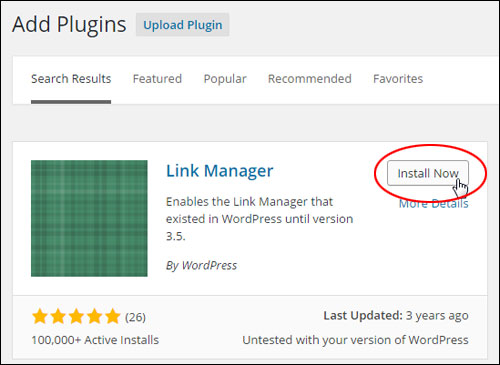
Activate the plugin …
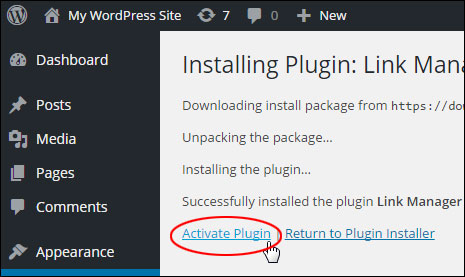
After activation, a ‘Links’ item will get added to the WP admin menu area …
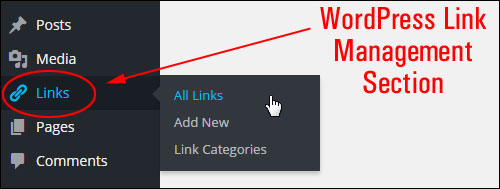
(Links menu)
Configuring Link Manager
We recommend setting up your link categories first before you start adding links. This way, you can assign new links to link categories you have already created.
Link Categories
To create a new link category, click on Links > Link Categories in the dashboard menu …
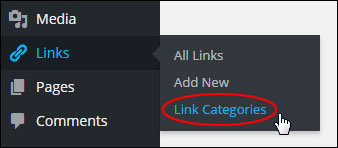
(WordPress Links Menu – Link Categories)
The ‘Link Categories’ screen will display in your web browser.
Enter information into the following fields:
- Name: Whatever you enter here displays as the category your links will be assigned to.
- Slug: The slug is the URL bit of the link category. It must all be in lowercase letters and contain no spaces (use hyphens to separate words).
- Description: Some themes may display your link category description.
When done, click the Add New Link Category button to save …
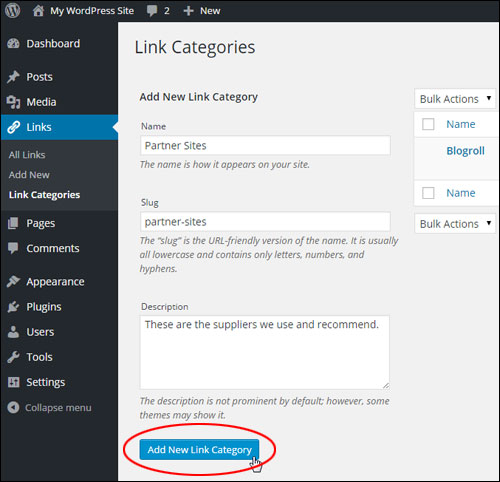
(Link Categories)
The link category will be added to the table …
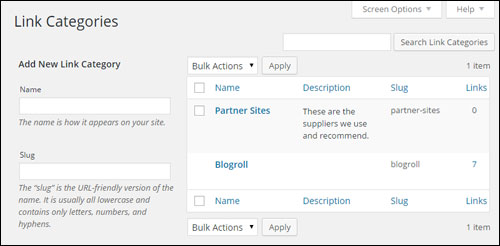
(Link Categories)
![]()
Tip: The default WordPress link category is called Blogroll . Unless you specify a category for a new link, WordPress will assign new links to the default category …
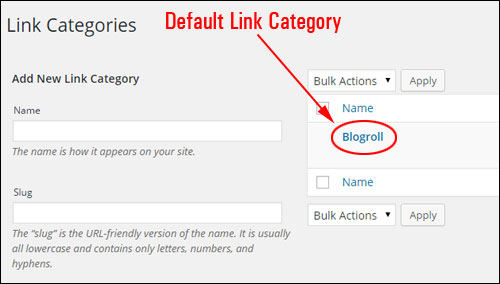
(Default link category)
You may want to change this to something better suited to your business. This not only makes it easier for visitors, but any new links that you add to your site will automatically display under the new category name …
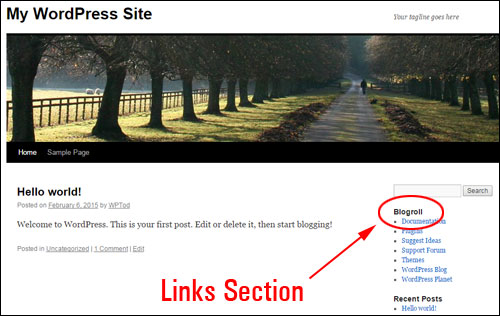
(we recommend changing the default link category name to something your visitors will relate to)
To change the ‘Blogroll’ link title, hover your mouse over the list item and click on the Quick Edit link …

(Quick Edit)
Replace both the Name and the Slug with a new category name (remember to keep the slug in lowercase letters and replace all spaces with a hyphen), then click on Update Link Category …
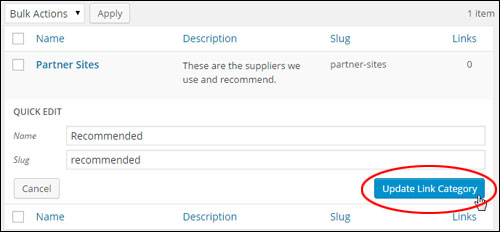
(Editing the default link category name)
Replace the link category name ‘Blogroll’ with a name more suitable to your purposes (e.g. ‘Recommended’, ‘Our Sponsors’ etc).
Let’s insert a link category description. To add a description to an existing link category, hover over the item name and click Edit …
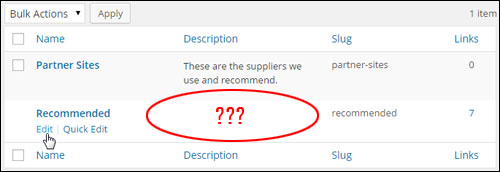
(You can add/edit the category description)
Add your link category description field and click Update …
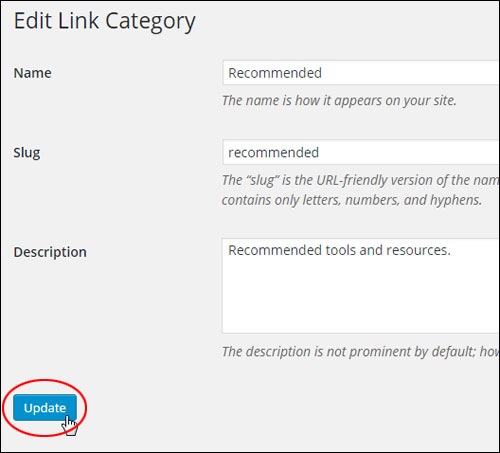
(Edit Link Category page)
Repeat this process and add as many different link categories as your site needs.
After you have finished configuring your link categories, you can being adding new links.
Adding New Links
To create a new link, go to the main dashboard navigation menu and click on Links > Add New …
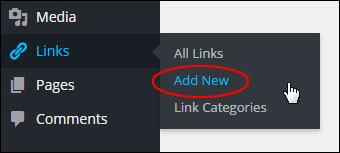
(Links Menu – Add New)
This takes you to the ‘Add New Link’ page …
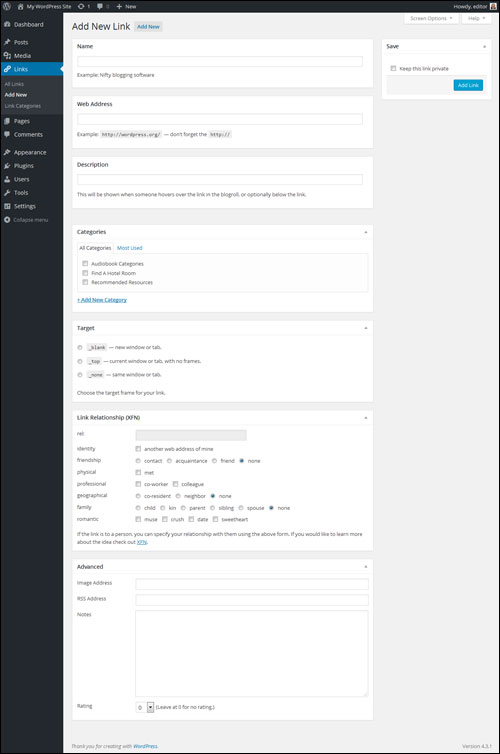
(Add New Link screen)
You can also reach this page by clicking on the ‘Add New’ button at the top of the main Links screen …
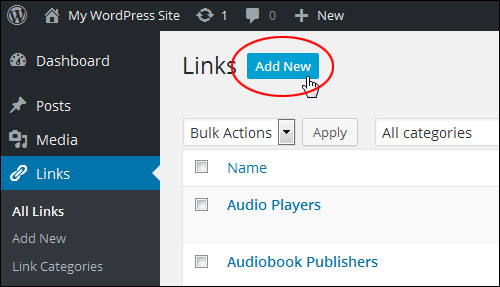
(Links screen – Add New Link button)
The ‘Add New Links’ page includes the following sections:
Name, Web Address & Description
Enter your link details in this section …
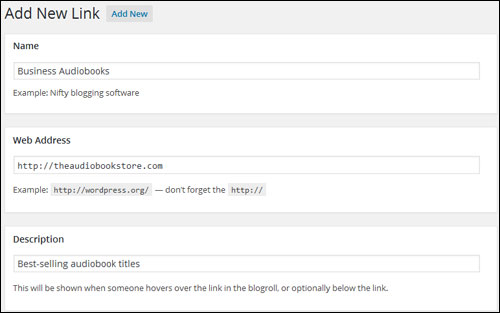
(Name, Web Address, Description section)
Enter the following information:
- Name: Whatever you type in this field will display as the category your links will be assigned to.
- Slug: The slug displays in the URL of the link category. It must be in lowercase letters and contain no spaces (use hyphens to separate words).
- Description: Some themes may display a link category description. (Optional)
Categories & Target
Select a Category and Target for your link …
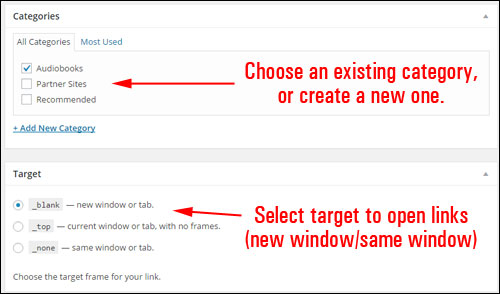
(Categories & Target)
In the Categories section, tick a link category you have already created, or click on the ‘+ Add New Category’ link to add a new category.
Also, select a target frame for your link in the Target section by choosing one of the radio buttons. This lets you specify where the link should open when clicked on by visitors:
- _blank means that when visitors click on the link, a new, separate web browser window will open up to display the information for that link.
- _none means that when visitors click on your link, they will leave your site and a new website or page will load in your browser window instead.
- _top opens the link at the top level of the frame system if you’re using frames. If you don’t use frames, or if you don’t know what frames are, then ignore this option.
Link Relationship XFN
This section provides some additional link functionality …
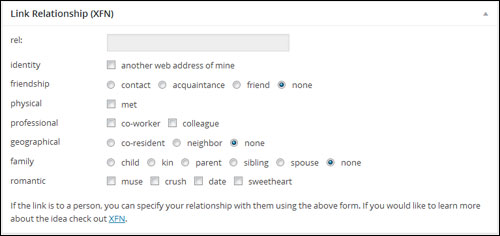
(Add New Link – Link Relationship (XFN) area)
Link Relationship (XFN) – XFN (XML Friends Network) allows you to define your relationship with the linked person. For example, if you have a professional relationship with Ananya O’Malley and you link to her blog, you would probably check co-worker or colleague.
XFN relationships are optional for WordPress links. You can ignore this section and all of your links will still work. Defining relationships with XFN makes the links defined on your site more understandable to some sites and search engines that use this information.
rel – This field lets you specify the ‘rel’ attribute that will be assigned to your link. The rel attribute is used to define a relationship between the current document and the linked document. For example, if you don’t want search engines to follow your link, enter nofollow into this field.
To learn more about XFN, visit the site below:
Advanced
The last section of the Add New Link’ screen lets you enter Advanced features for your links (some themes will ignore this. You can ignore this section, unless there’s a good reason to use it) …
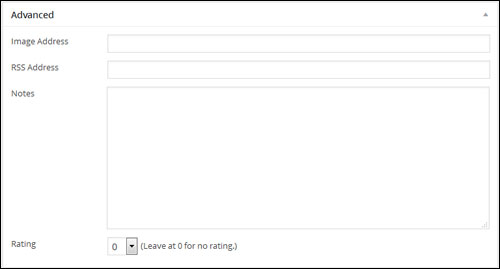
(Advanced link settings)
The Advanced link settings section contains the following:
- Image Address: Specify an image to be displayed with the link. To use this feature, add an image URL and make sure that the image is small (around 16×16 like a favicon).
- RSS Address: If your theme allows it, the RSS feed associated with the link will display next to your link.
- Notes: Add notes about the link in this section for your own internal reference.
- Rating: You can add a rating score to the link if you want to sort links by rating (see the ‘Links’ widget section below).
Type in your information into the above fields or just leave this section ignore this section.
When you have finished adding information about your link, click on Add Link to save your new link …
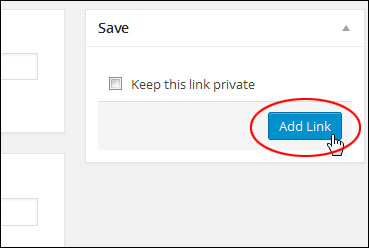
(Click on Add Link to update your link settings)
![]()
Note: If you select the Keep this link private checkbox, your link will not be visible when links are displayed on your site …
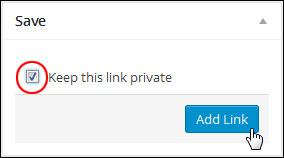
(Make links private by checking the box)
Making a link private lets you toggle its visibility on or off without deleting it (this is useful if you want your link to display during certain periods and hide it afterwards) …
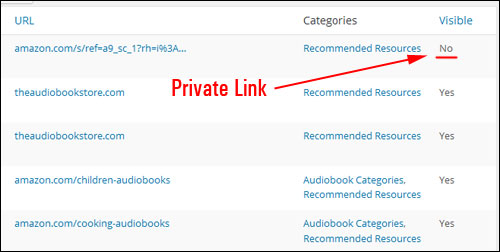
(Making links private toggles their visibility on and off)
To view all the links you have added to the Link Manager, go to your WP dashboard navigation menu and select Links > All Links …
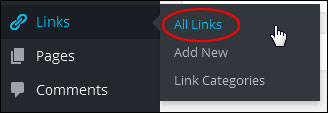
(WordPress Links – All Links)
The ‘Links’ page will display in your web browser. The table of links displays all your links and link information (e.g. link URL, link categories, rating, etc.) …
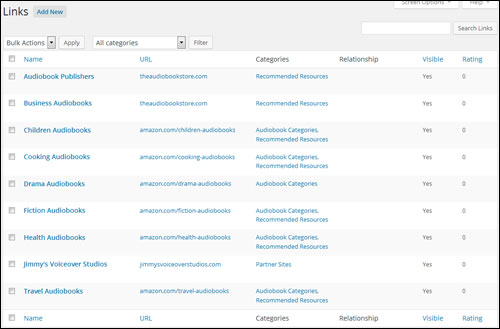
(List of links)
![]()
Tip: To view or hide options in the Links table, click on the ‘Screen Options’ tab near the top of your screen …
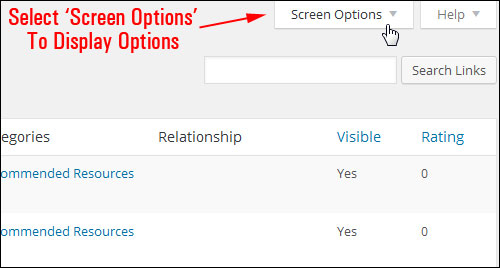
(Links screen – Screen Options)
Enable/disable information on your table of links by ticking/unticking their check boxes …
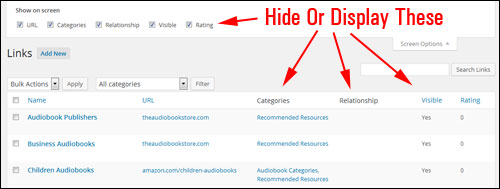
(Show/hide links)
Editing Your Link Information
To edit links in the Link Manager, go to the dashboard navigation menu and click on Links > All Links to bring up the links screen …

(WordPress Links Menu – All Links)
Locate the item you want to edit and click on Edit to bring up the link’s information …
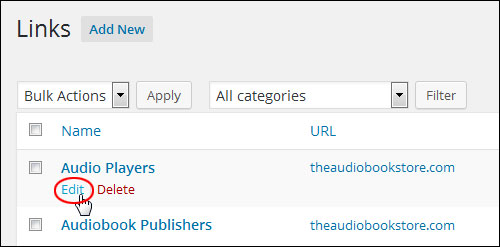
(Editing your links)
Edit your link information …
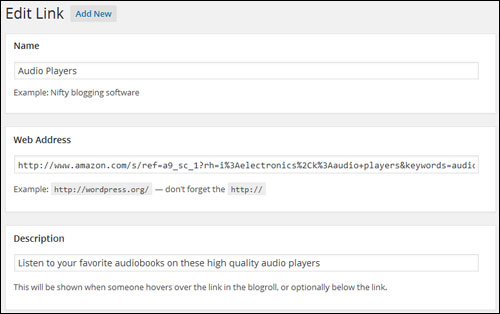
(Edit Link screen)
After editing your link, you can:
- Click on Update Link to save your link details,
- Click on Visit Link to see your link and check that you have set up everything correctly (the link will open up in a new window),
- Click Delete to delete the link from your table of links …
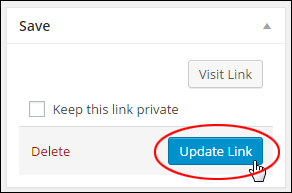
(Update Link button)
How To Remove Links
To delete links from the Link Manager, go to your navigation menu and choose Links > All Links …

(WP Links Menu – All Links)
You will be taken to the ‘Links’ table.
You can delete links individually, delete multiple links, or perform a bulk delete.
To delete links individually, hover your cursor over the link title that you want removed and click Delete …
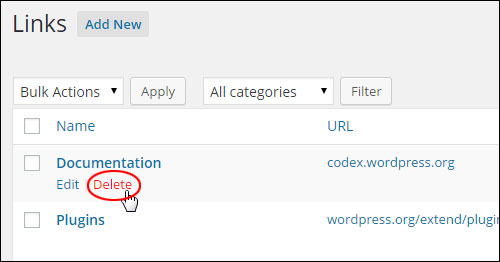
(Delete your links)
To delete links in bulk, either tick the check box next to every item that you want to remove, or select all links by clicking on the main checkbox next to the ‘Name’ column header …
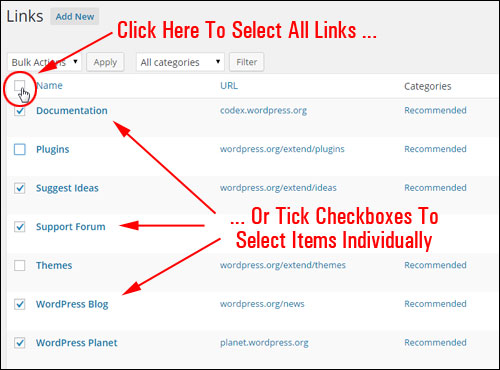
(Deleting multiple links)
Choose Delete from the ‘Bulk Actions’ drop-down menu, and click the Apply button to delete all selected links …
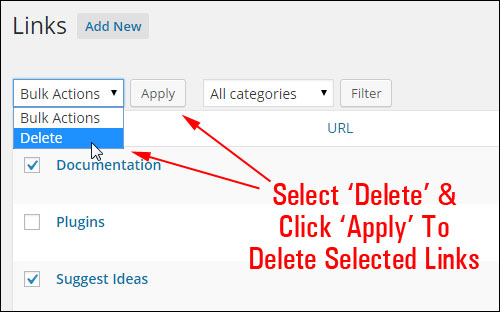
(Bulk-deletion of links)
All the links you have selected will be removed …

(Link deletion message)
Plugin Usage
Now that you know how to configure link categories and how to add, edit and delete links, let’s show you how to display your links on your site.
Links Widget
The Link Manager plugin adds a ‘Links’ widget to your ‘Widgets’ page.
To access and configure your Link widgets, go to your WP admin menu and choose Appearance > Widgets …
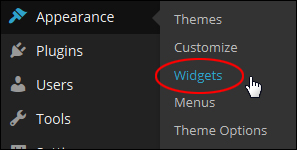
(Appearance Menu – Widgets)
This takes you to the ‘Widgets’ screen.
You will notice a ‘Links’ widget in the Available Widgets section …
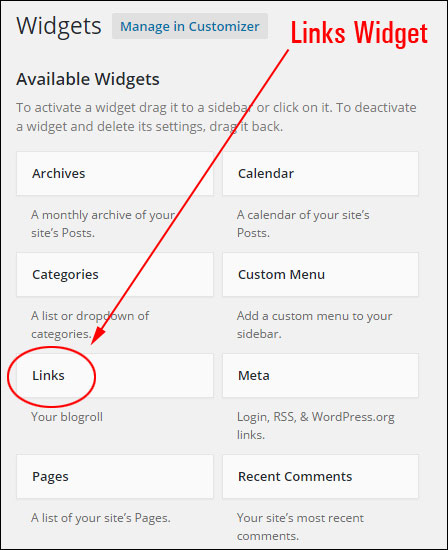
(Links widget)
To make the ‘Links’ widget active, drag the widget to one of your widget sections in the Widgets screen and drop it wherever you would like your links to show up …
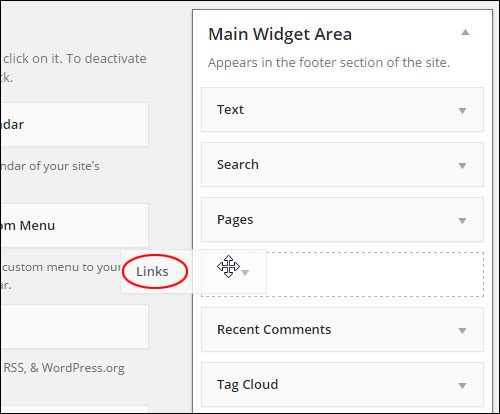
(Drag and drop the links widget to add it to a widgetized area)
The Links widget provides various settings. For example, you can specify what information you want to display about your links and how many links you want displayed on your sidebar …
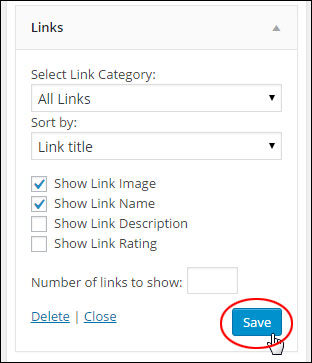
(Link widget - options)
You can also add as many link widgets as you want. This allows you to add and display different lists of links sorted by categories throughout your site …
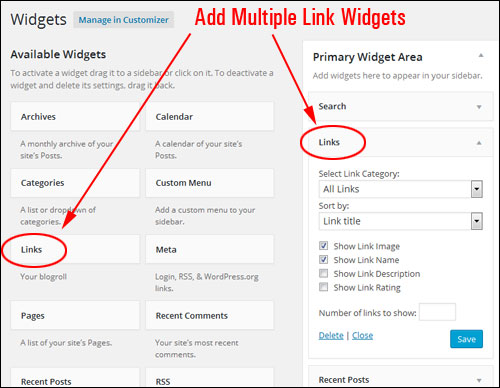
(Add multiple link widgets to your sidebar)
Select a link category from the ‘Select Link Category:’ drop-down menu …
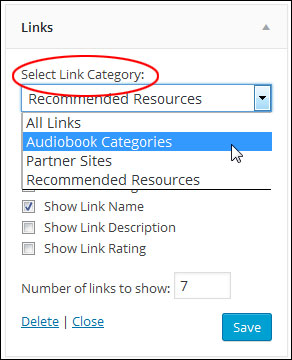
(Link widget settings – Select Link Category)
You can sort links by Link title, Link rating, Link ID, or display links in Random order …
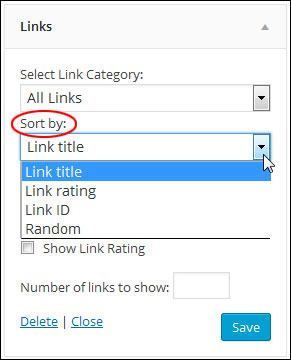
(Link widget settings – Sort by options)
After configuring your Links widget, click Save to update your settings. A links will show on your website or blog’s sidebar …
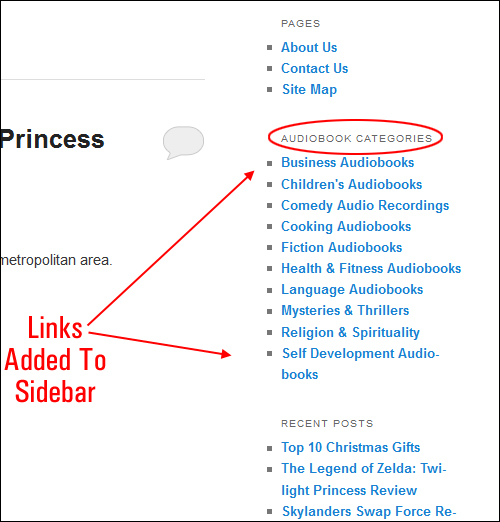
(An example of how links can be displayed on your site’s sidebar)
As the above example shows, you can display specific links to your site visitors (e.g. a list for a specific link category only), and add multiple lists of links to your sidebar menu.
![]()
Need more help with widgets? To learn more about configuring widgets, refer to this article:
Links Manager – Additional Information
If you have loads of links, the Link Manager plugin lets you easily administer these with filtering, searching, and sorting functionality.
Sorting Links
You can sort links by hovering your mouse over the title of the column you want to sort and clicking on the black triangle displayed next to the column title …
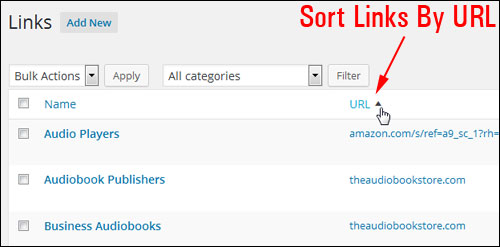
(Sort links function)
Searching Links Function
Find links using the ‘Search Links’ feature …

(Finding links)
Filtering Your Links
You can filter links by category …
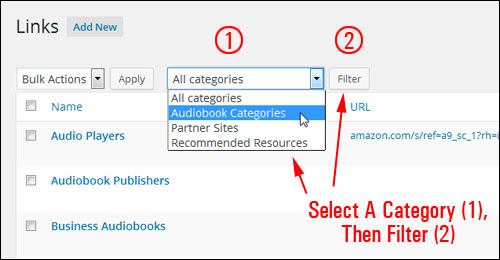
(Filtering links by categories)
You can also search and filter links in the Link Categories page. Use the ‘Search Link Categories’ button to search for link categories, or click on the links in the ‘Links’ column …
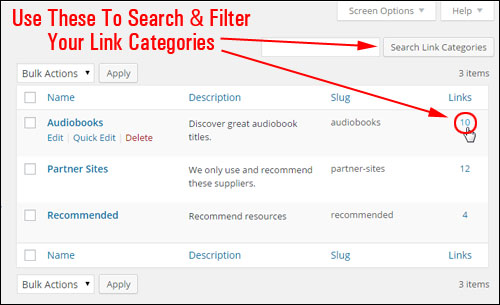
(searching and filtering links in the Link Categories screen)
This brings up a list of all links listed under a specific link category …
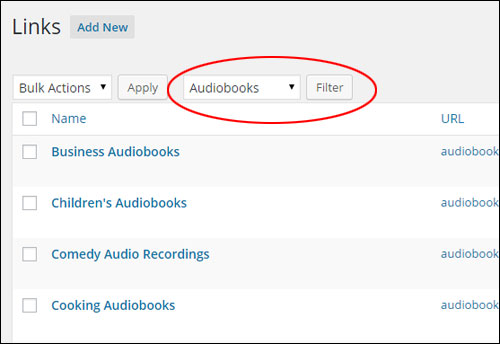
(Links filtered by link category)
Additional Link Options
If you plan to use links extensively on your site, or if you want to add a ‘Links’ page to your site (i.e. not just add links on your sidebar), then you may want to consider using a plugin that can help you administer links.
Link Library

(Link Library Plugin)
Plugin URL
http://wordpress.org/plugins/link-library/
Plugin Description
This plugin lets you output a list of all your link categories and a complete list of all your links with notes and descriptions …
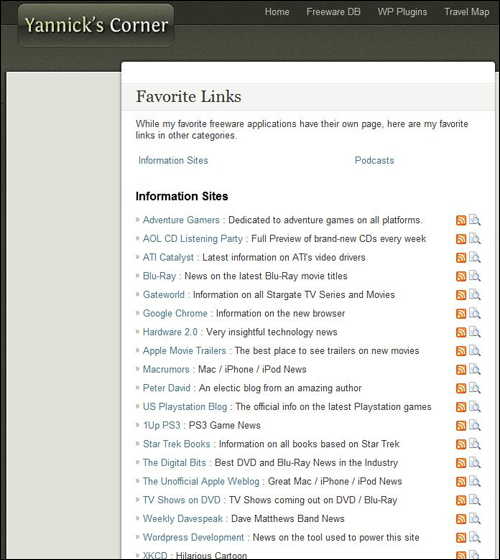
(Link Library links. Image sourced from Link Library plugin website.)
This plugin creates a page on your web site containing a list of all of the link categories in your Links area, and all links defined for these categories. You can select a sub-set of categories to display or not display, show only one category at a time, display a search box and find results based on visitor queries, display a form to accept user submissions that can be moderated by a site administrator, and even generate an RSS feed for your links that lets your site users become aware of any additions made to to your link library.
To learn more this plugin, go here:
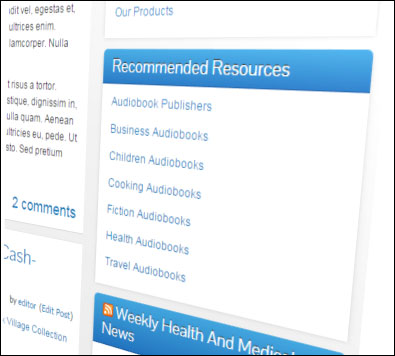
Congratulations! Now you know how to add a link section to your WordPress site.
![]()
We have written a comprehensive article about how to easily add HTML links into WordPress posts. To learn more about this go here:
***
"Wow! I never knew there's so much to learn about WordPress! I bought one of the WordPress for Dummies three years ago, such authors need to be on this course!" - Rich Law, Create A Blog Now